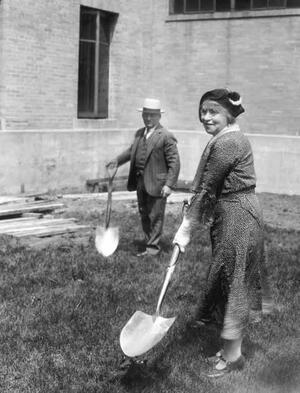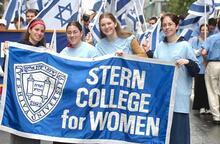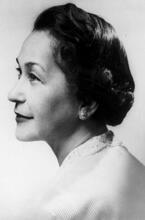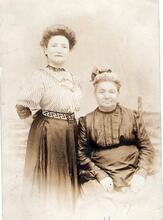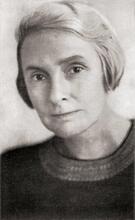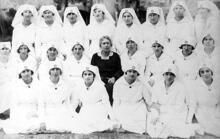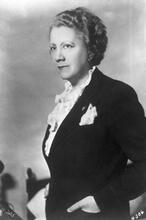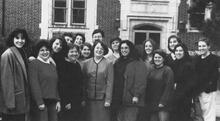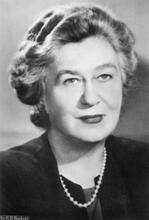Hadassah in the United States
Courtesy of the American Jewish Historical Society.
When seven women concluded on February 14, 1912, “that the time is ripe for a large organization of women Zionists” and issued an invitation to interested friends “to attend a meeting for the purpose of discussing the feasibility of forming an organization” to promote Jewish institutions in Palestine and foster Jewish ideals, they scarcely anticipated that their resolve would lead to the creation of American Jews’ largest mass-membership organization. Yet Hadassah, the Women’s Zionist Organization of America, became not only the most popular American Jewish organization within a short span of years, maintaining that preeminence to this day, but also the most successful American women’s volunteer organization, enrolling more women and raising more funds than any other national women’s volunteer organization.
Introduction
Hadassah, the Women's Zionist Organization of America, has been the largest Zionist organization in the world, one of the largest American women's volunteer organizations, American Jews’ largest mass-membership organization, and probably the most active Jewish women's organization ever. Hadassah unites women in Zionist activity, rather than being a feminist organization explicitly aimed at the betterment of women. As such, it is different from other major Zionist women's organizations, including the Women International Zionist Organization (WIZO), which operates all over the world and has focused on improvements for women mainly in the Jewish community in Palestine prior to the establishment of the State of Israel. "Old Yishuv" refers to the Jewish community prior to 1882; "New Yishuv" to that following 1882.Yishuv and Israel. It is also the only women’s Zionist organization that has given aid to the population of the entire Yishuv and Israel (including health and medical aid to the Arab population), unlike other women's Zionist organizations that acted for the benefit of a specific sector (women, the religious population, etc.). Hadassah’s scope of activities was broad, ranging from social feminist activities to medicine to political activity. For most of the organization’s existence, about two thirds of its activity has focused on its projects in the land of Israel and about one third on the United States.
Founding
Women's Zionist associations—called Daughters of Zion, and frequently adopting the name of a famous woman in Jewish history, such as Rebecca, Deborah, or Hadassah—first emerged in the last decade of the nineteenth century. Other such associations were established within the American Zionist Federation (which became the Zionist Organization of America, or ZOA, in 1918). These groups mainly engaged in discussions of Jewish history, Palestine, and, after the official founding of the Zionist movement in 1897, the movement itself.
In 1907, Henrietta Szold (1860-1945)—a distinguished figure in the German American Jewish elite, the only woman who was invited to the founding of the Jewish Publication Society of America and JPS’s editorial secretary for more than twenty years—joined one such group. Founded in 1899 in Harlem, New York, the group was called Hadassah and revolved around discussion of major Zionist thinkers. Szold, however, felt the group lacked a direction. In 1909 she visited Palestine and was deeply moved by the lack of health services, poor sanitary conditions, gloomy economic situation, and general misery of the Yishuv. When she returned to the United States, she persuaded the group's members to found a national Zionist women's organization with the aim of promoting health services in Palestine. On February 14, 1912, Szold, together with six other women, concluded “that the time is ripe for a large organization of women Zionists” and issued an invitation to interested friends “to attend a meeting for the purpose of discussing the feasibility of forming an organization to promote Jewish institutions in Palestine and foster Jewish ideals."
The first meeting drew 38 female Zionists to the vestry rooms of New York City’s Temple Emanu-El on February 24, 1912. Most had been born, raised, and educated in the United States. At the meeting’s conclusion, almost two-thirds of those in attendance were elected officers or directors, suggesting the leadership opportunities Hadassah would offer women. The women involved included the seven signers of the initial invitation: Henrietta Szold, at age fifty-two, was the senior leader, deeply committed to Zionism as a political and moral movement of Jewish renewal; Mathilde Schechter was married to Solomon Schechter, the distinguished scholar, religious thinker, and president of the Jewish Theological Seminary (JTS); Emma Leon Gottheil was the wife of the first president of the Federation of American Zionists (FAZ) Richard Gottheil and traveled in elite Jewish and gentile social circles; Rosalie Solomons Phillips, a wealthy and respected member of New York City’s oldest Descendants of the Jews who lived in Spain and Portugal before the explusion of 1492; primarily Jews of N. Africa, Italy, the Middle East and the Balkans.Sephardic congregation and a descendant of Revolutionary War hero Haym Salomon, participated in various Jewish and gentile societies and was married to N. Taylor Phillips; Sophia Berger led the Harlem Daughters of Zion study group; Lotta Levensohn, graduate of the Teachers Institute of JTS, worked as secretary to Rabbi Judah Magnes of the New York Kehillah and belonged to one of the three Daughters of Zion study groups that became a nucleus of Hadassah; and Gloria Goldsmith, at age twenty-one the youngest of the seven, had already helped found Young Judaea and enthusiastically supported Zionism as an expression of Jewish idealism.
The cooperation of these seven women indicates how the idea of Hadassah inspired support from a broad spectrum of American Jewish women. Despite differences in age, background, marital status, and wealth, Hadassah’s early leaders shared, in addition to their Zionism, strong Jewish educations and an eagerness to act in concert with other women at a time when women could not vote and were denied many of the perquisites of citizenship and independent action.
Hadassah recruited a leadership cadre from women of Eastern European, German, and Sephardic backgrounds. The older women “gave Hadassah the high prestige of their moral support at a time when Zionism was neither fashionable nor popular, and individual Zionists were often regarded as crackpots,” Levensohn recalled. Many of the first members, both young and middle-aged, were native-born, college-educated American Jews. Their level of formal learning was unusual for women in this period and signified their cultural aspirations. Often mavericks in their social class, Hadassah leaders were attracted to Eastern European Jews not as objects of assimilation or as inferiors needing help but as “real” Jews; they were practical idealists. The first board of directors reflected the amalgamation of three groups: young women of the Daughters of Zion study circles, older prominent Zionists, and members of Alice Seligsberg’s ethics study group. Many of Hadassah's first generation of national leaders never married.
In its first year, Hadassah adapted aspects of women’s public activities to create a flexible Zionist organization. Aspiring to national stature, it modeled its structure on the National Council of Jewish Women. Local chapters linked women irrespective of class, marital status, age, or immigrant background. Although each area contained only one chapter, different groups reflected members’ particular interests, including study and sewing circles that sent their products to the needy in the Yishuv, English- and Yiddish-language groups, and daytime and evening meetings. Hadassah recruited women from varied socioeconomic and ethnic backgrounds, but many were working women—teachers, stenographers, shopgirls, and garment workers. Yiddish-speaking women, however, were under-represented.
Meetings were held in private homes, and Seligsberg recalled that “for reasons of economy, we decided to hold parlor meetings only in houses provided with electric current since acetylene needed for lantern pictures would be an extra expense.” Lantern pictures conveyed Jewish women’s plight in Palestine and their need for adequate maternity care.
At its inception Hadassah focused on women’s health issues, reflecting the social feminism of settlement-house work. At the first meeting, the founders resolved that the organization would undertake a nursing project for women and children in Palestine. In January 1913, with 122 members and $542 in dues collected, Hadassah decided to send two American Jewish public health nurses to Palestine. The project was enabled by funds provided by philanthropist Nathan Strauss and a number of wealthy Chicago non-Zionists. The two nurses, Rose Kaplan and Rachel [Rae] Landy, arrived in Palestine and established Hadassah’s Nurses Settlement in Jerusalem, a first step to “bring order to that land of chaos.” (See Hadassah: Yishuv to the Present Day, Early Work in Palestine.)
The decision signaled organizational growth. After it was reported that the nurses needed guidance, Hadassah created a Palestine Advisory Committee in New York City to supervise them, setting an important precedent that policy decisions were to be made in America. In 1914, this committee evolved into the Central Committee, later to become the National Board. By July 1913, Hadassah had chapters in Philadelphia, Boston, Baltimore, and New York. Sarah Kussy, who founded Hadassah in Newark in 1914, described it as “composed not of swells, nor of the very poorest class of people,” but of “women who have regard for the meaning of a dollar.” In 1917, when Hadassah had 53 sewing circles, fourteen asked for Zionist literature to be read aloud as the women sewed. Of these circles, ten requested English literature and four Yiddish.
On June 19, 1914, Hadassah held its first national convention in Rochester, New York, where it officially adopted the name Hadassah and its purpose: “to promote Jewish institutions and enterprises in Palestine and to foster Zionist ideals in America.” Hadassah had already chosen a motto, suggested by Israel Friedlaender, from Jer. 8: 19–23, Arukhat Bat Ami, translated as “The Healing of the Daughter of My People,” and a seal, designed by Victor Brenner, the designer of the Lincoln penny, of myrtle [hadas, or Hadassah] branches around the traditional Jewish icon the Shield of David on a blue background. Hadassah affiliated with the Federation of American Zionists (FAZ).
The Interwar Period
World War I challenged Hadassah, which had 34 chapters and 2,100 members when the United States entered the war in April 1917. Turkish repression of Zionist activities in Palestine forced Hadassah to close its Nurses Settlement in 1915. At home, domestic politics strained Hadassah’s unity. Many leaders, including Szold, Seligsberg, Levensohn, Sampter, Nellie Straus, and Gertrude Goldsmith Rosenblatt (who married the Zionist activist Bernard Rosenblatt), identified as progressives and advocated socialism, racial equality, and, most important, pacifism. Other leaders, including Emma Gottheil, Sofia Berger, and Ruth Bernard Fromenson, ardently supported the Allies. At a protracted meeting on the issues in October 1917, Szold agreed to resign from the antiwar People’s Council for Peace and Democracy for the sake of Hadassah.
In 1918, Hadassah merged (voluntarily) with the restructured Zionist Organization of America (ZOA), according to a plan formulated by Louis Brandeis to create a more efficient organization structure. As a result, it became completely subordinate to the ZOA and almost disappeared as a semi-independent entity. It surrendered its practical program and authority, two key elements of its organizational identity. It continued raising money, but the funds it collected were directed to Palestine through the ZOA and the World Zionist Organization.
In 1920, after seven members of Hadassah’s Central Committee were told they had to resign because the committee refused to raise money for the Zionist fund Keren Hayesod, Hadassah began to reassert its autonomy. This was reflected, among other measures, by starting the Hadassah Newsletter nineteen months after it had discontinued its previous Bulletin. Rose Gell Jacobs, later one of Hadassah's most prominent leaders, became the editor.
In 1921, Hadassah became semi-autonomous from the ZOA. That same year, Alice Seligsberg, who had returned from two years in Palestine where she had been the administrative head of the American Zionist Medical Unit (AZMU, sent to Palestine in 1918 to give medical aid to the Yishuv, see details in Hadassah: Yishuv to Present Day, Early Work in Palestine), was elected president as Szold departed for Palestine. Although Szold served again as president for three years beginning in mid-1923, she effectively passed the leadership to younger women.
Also in 1923, Hadassah and WIZO reached an agreement according to which Hadassah would operate in the United States, while WIZO would be responsible for organizing Zionist women in all other parts of the world. This agreement was basically kept until the beginning of the 1980s.
By the mid-1920s, Hadassah had become the largest Zionist organization in America and a substantial force in the American Jewish community, while the ZOA membership declined. Nevertheless, serious clashes arose throughout the 1920s between Hadassah and the male-led ZOA regarding Hadassah’s autonomy, respect as a Zionist group, and Hadassah's objections to some of the ZOA policies.
In mid-1926, when Hadassah had almost achieved autonomy, Irma Levy Lindheim became president. Under her leadership, Hadassah initiated its first partnership with the Jewish National Fund, in 1927. When Lindheim could not continue in a second term because of family problems, Zip Falk Szold, a Bryn Mawr graduate and wife of the distinguished Zionist leader and Henrietta Szold’s cousin, Robert Szold, accepted the position in 1928. By this time, membership had reached over 37,000.
Under an agreement reached in 1933, Hadassah finally achieved almost total autonomy from the ZOA, leading to its independent entrance into Zionist politics, the launching of new projects, and an increase in its power overall.
Ideology: Feminist, Zionist, and American
From its inception, Hadassah created a new version of American Zionism, both ideologically and practically. It was women’s Zionism, or at least another kind of American Zionism. Hadassah’s ideology emerged from two major influences: the ideas of its founders, particularly Szold’s Zionism and feminist assumptions, and the ideas of American Zionist leaders and thinkers, mainly Louis Brandeis, who formulated the leading principles of American Zionism, and Rabbi Mordecai Kaplan’s Zionist notions.
Hadassah’s founders’ most basic organizational assumption was separatism from Zionist men. The premise of the organization's founders and their successors was that women should be organized and operate apart from men within female-only organizations. In accordance with contemporary social feminist views, Hadassah’s founders also believed women were more qualified for practical work than for ideas and ideologies. They concluded that, with respect to Zionist work, men were more qualified to deal with the political sides of nation-building, while women were better qualified to work in the traditionally female spheres of education and health. The founders believed that women and men could make equal contributions to Zionist goals but in different areas.
Hadassah’s founders also believed that in order to create and maintain a women’s organization, members should be motivated by specific concrete projects. As early as 1913, Szold argued that the key to energizing Hadassah was basing it on a long-term activity of "practical philanthropy that occupies itself with the needs of women and children [because it] …makes an appeal to all American women." Szold’s idea was building the Land of Israel in women's way, i.e. through practical projects. As a result, "doing" became the major characteristic of Hadassah's ideology and practice for years to come.
Hadassah’s founders thus focused from the beginning on long-term projects. They chose projects that gave women a role in the American as well as world Zionist movements, had special appeal for women but did not challenge gender norms in the Jewish or American society, and did not compete with men.
Although from its inception Hadassah has always worked to give women a distinct place in Zionism, it generally did not strive to promote women’s status or welfare only, neither in the United States nor in Palestine. Moreover, although its initial project was aimed at helping children, its major work in the Yishuv was medical, so its activities specifically on behalf of women gradually decreased. None of its constitutions or major documents include explicitly feminist aims. An exception was its active support for Yishuv women’s suffrage and equality in the Mandatory period.
The Zionist orientation of Hadassah's founders differed from that of the male Zionist leaders, who criticized Hadassah for not engaging in work designed to change Jews into a self-conscious political entity. Hadassah, they claimed, merely engaged in charitable endeavors to improve living conditions in the Yishuv. In fact, Hadassah’s decision to establish an urban nurses’ settlement ran counter to Zionist emphasis on cooperative rural settlements and European Zionist methods of colonization. In its early days and some of its later health work, Hadassah stressed woman-to-woman work and work for children on humanitarian grounds, as well as on American social feminist ideology.
Hadassah’s Zionism was a form of practical idealism that Szold considered characteristically Jewish. “Zionism as we dreamed it in America,” Sampter wrote in 1921, “was the dream of a regenerate humanity.” Hadassah also avoided religious controversy: The only two holidays it celebrated were Purim and Hanukkah. Hadassah urged its members to express their Jewish identification through work for Palestine. As Hadassah’s first president from 1912 to 1921, Szold wanted to mold “a compact, self-reliant organization … to foster solidarity, to weld thousands of women scattered all over the country into a homogeneous group.” Hadassah actively recruited non-Zionist women as well. It resisted efforts to decentralize and established an administration fund—a novelty in Jewish organizational circles—to cover costs of its central administration.
Hadassah’s brand of Zionism was heavily influenced by Louis D. Brandeis' claim that every American Jew must become a Zionist and that American, Zionist, and Jewish identities were complementary. Hadassah aspired to be a broad Zionist movement that would include every American Jewish woman. Its Zionism was greatly infused with Americanism and American patriotism, and it adhered to the American ethos and commitment to democratic ideals.
Hadassah's admiration of American science, technology, and professionalism, especially in its medical activities in Palestine, reflected its American patriotism. The history of Hadassah's enterprises in the Yishuv and Israel is the history of importing American models in medicine, welfare, and vocational education and reflects Hadassah's threefold identity as female, American, and Zionist: American since these were "American-born" projects, Zionist as it was aimed at the Yishuv, and female because the projects were appropriate for women.
Jewish Education and Fostering American Zionist Youth Movements
The most important manifestation of Hadassah's aim "to foster Zionist ideals in America" was focused on two major paths: educating Hadassah women in Zionism and Judaism and nurturing American Zionist youth movements.
From the outset, self-education was a central feature of Hadassah’s social activities. Study groups existed from Hadassah’s earliest days, and Jessie Sampter initiated its modest education program in 1913, only about a year after the organization's founding. In November 1914, the Hadassah School of Zionism opened. Its major goal was to instill among Hadassah members commitment to Jewish, and particularly Zionist, ideas; it also trained Hadassah members to speak in public. In 1934, it continued its work in adult education by sponsoring the School for the Jewish Woman under the direction of Trude Weiss-Rosmarin; the school conducted afternoon and evening classes for married and single women with a curriculum that included Hebrew, Bible, Talmud, Jewish history, and ethics. But turbulent relations between Hadassah and the strong-willed director soon led to the school’s dissolution.
In the late 1940s, great efforts were made to increase Hadassah’s Jewish educational activity. Through the 1950s at least, Hadassah considered itself a highly significant force in securing “creative” Jewish life in America. A special Education Department was set up in the Hadassah’s national office in New York, responsible for developing material and courses in Jewish and Zionist subjects. In 1947 this department republished The American Jew: A Composite Portrait (first published in 1942), edited by Oscar I. Janowsky, as well as Milton Steinberg's books The Making of the Modern Jew (first published in 1934) and Basic Judaism.
Since then, the Education Department issued many publications, books, booklets, and other educational materials on Jewish and Zionist subjects. (As a result of changes caused by second-wave feminism, in the late 1980s the department began to publish in other areas of interest to Jewish American women as well.) In 1951, a professional director was installed as head of the Education Department, in addition to the volunteers.
Further, the Hadassah Newsletter included articles on contemporary issues by well-known public figures and recommended books on Jewish subjects. Study groups also gathered once a month to study material developed by the Education Department. The study groups were modeled on a method first used in the American Jewish community in the early twentieth century by the National Council of Jewish Women, which had in turn been shaped by turn-of-the-century American women’s clubs. At least in the mid-1950s, however, only a tiny minority of Hadassah membership took part in the study groups.
Finally, a Hadassah Speaker’s Bureau helped spread Hadassah’s message throughout the country. It provided lessons in public speaking for women, so critical to their assumption of leadership positions within Hadassah.
Junior Hadassah
In 1920 the Hadassah national convention adopted a resolution to create the Junior Hadassah, for girls eighteen to 21. The young women immediately adopted the care of war orphans in the Yishuv. Szold suggested their motto: “A joyful mother of children.” By 1923, Junior Hadassah had its own leaders. Frieda Silbert of Boston served as its first chair, and Mignon Levin Rubenovitz, a graduate of Columbia University’s Teachers College and early Hadassah member, was senior adviser.
Hadassah also helped establish the American Zionist Youth Commission in 1940, directed by Shlomo Bardin. Its leadership training programs proved quite successful both for Young Judaea and Junior Hadassah and paved the way for Hadassah supervision of the former.
Consolidation and Growth, 1933–1953
From the time Hadassah achieved complete independence from the ZOA in 1933, its organizational, political, and ideological autonomy allowed it to chart its own distinctive course as a women’s organization, to consolidate its achievements, to initiate new projects, and to expand its membership.
Hadassah’s membership grew substantially in the 1930s, as a result of Hitler’s rise to power in 1933, the rise of the German Jewish refugee problem, and Hadassah’s decision in 1935 to adopt Youth Aliyah (Hadassah: Yishuv to the Present Day, Hadassah and Youth Aliyah.) This Zionist project was founded in Germany in 1932 to save youth, and later also children, first from Germany and later from other countries, bringing them to Palestine and settling, educating and rehabilitate them there. Historian Erica Simmons claims that Hadassah's agreement to adopt the project was a natural outcome of its previous interest and activity in child welfare in the Yishuv. Youth Aliyah became perhaps Hadassah’s most popular practical project. Substantial membership growth also occurred following the revelation of the systematic murder of European Jews. Between 1935 and 1945, Hadassah’s membership increased from over 32,000 to over 176,973. A second great increase occurred in the aftermath of the war, in response to the problems of displaced persons and in the lead-up to the founding of the State of Israel; in 1947/8, the year of Israel’s founding, membership increased to 242,962. By 1952, Hadassah reached a new peak of almost 272,000 members. Critical to its broad appeal was the increase in the numbers of native-born American Jews who found its brand of American Zionism compelling.
Second- and Third-Generation Leaders and Members
Most of Hadassah’s top leaders from the 1930s through the 1950s came from the Eastern European immigrant Jewish community and were raised in New York. They were married women with children, educated in American public schools and later in American colleges. Most of them were trained as teachers and affiliated with the Conservative or Conservative-Reconstructionist streams of Judaism. (Most Hadassah members in the twentieth century were also affiliated with the Conservative movement.)
Hadassah leaders often cooperated with individuals associated with the newly established Reconstructionist Movement. They shared a common attachment to American democratic progressive traditions and deep dedication to Zionism as an international Jewish movement of renewal.
During the 1930s through the 1950s, Hadassah's Jewish identity was ethnic-cultural understanding of Judaism as a comprehensive culture in which religion was considered only one of several components. A substantial proportion of the top leaders in the 1940s and 1950s were graduates of the Teachers' Institute of the Jewish Theological Seminary led by Rabbi Mordecai Kaplan, bringing some of his thought to Hadassah. Kaplan's major notion of Judaism as a civilization and the Hebrew language, the attitude to the land of Israel, and the national Jewish history as components of this civilization, had great impact on Hadassah particularly on its educational orientation. The most prominent leaders during those decades were Rose Halpern, Judith Epstein, and Miriam Freund-Rosenthal, all raised in immigrant Zionist families. A second group of Hadassah leaders in this period were women of well-to-do German Jewish origin, either American or fleeing from Germany as a result of Hitler's rise to power. Etta (née Lasker) Rosensohn, Texas-born daughter of the well-known businessman and oil tycoon Morris Lasker, was the most prominent among this group of leaders.
Hadassah entered the family lives of many American Jewish women. Its leaders and members often were daughters of mothers who had been Hadassah activists. These mothers transmitted a love of Zionism and Palestine to their daughters some of whom actually visited the land of Israel, as did Miriam Freund-Rosenthal in 1935 and Sara Nicholson Evans in 1933. The eldest of eight daughters, Evans accompanied her mother, Jennie Nicholson, who had founded a Hadassah chapter in North Carolina in 1919 after an inspiring meeting with Henrietta Szold in Baltimore. Evans subsequently organized for Hadassah throughout the South in the 1940s and 1950s, gaining a reputation as Hadassah’s “Southern accent.” All eight Nicholson daughters served as presidents of local chapters. Such family connections contributed to Hadassah’s impressive growth. The pace did not slacken until 1953.
The Second World War Period
A few days after the beginning of World War II, Hadassah and the ZOA founded the Emergency Committee for Zionist Affairs, which was eventually made up of the four major American Zionist organizations; Hadassah was the only women's Zionist organization to take part. In 1941 Hadassah had five representatives on the Committee, the same number as the ZOA, allowing it to take part in the formation of the American Zionist movement's policy.
Hadassah was also active in helping the American war effort. By February 1942, about two months after the United States entered the war, it had pledged full support for the United States war effort. One of the most prominent manifestations of this commitment was the raising of over $200,000,000 in war bonds. In 1942 Hadassah was the fifth largest contributor to the American war effort.
For a variety of reasons, when information about the mass murder of European Jews arrived in America in 1942, Hadassah "buried" the information in the back of its bulletin and scarcely dealt with it in the internal sessions of its national board. Prominent among those reasons was the leadership's fear that members would leave the organization, resulting in great damage. The leadership also saw Hadassah's role as saving Jewish children, not all of European Jewry. Its leadership and members made an enormous effort on behalf of Youth Aliyah, beginning in 1935 through the end of the war and after. Hadassah, then, saw its role during the Holocaust as focused on rescuing children and youth.
Political Involvement in the World Zionist Organization (WZO)
In the late 1930s, Hadassah began to forge an independent political path in the Zionist movement, crossing an important gender boundary. The major figure to push for political activity was Rose Jacobs. In 1937, Hadassah ran its own slate of eighteen delegates to the WZO Congress and started efforts to gain responsibility and political influence within the broader Zionist movement. In the 1940s it took on a central role in the World Zionist Movement's institutions and reached the highest levels of its administration, attempting to influence Zionist policy in several areas, especially Arab-Jewish relations.
From the 1920s through the early 1940s, Hadassah saw Jewish-Arab relations in Palestine through the lens of cultural pluralism. Many Hadassah leaders believed Jews and Arabs in Palestine could and must live side by side in peace. This view corresponded with feminist beliefs in the post-World War I period that women, unlike men, had the ability to heal the world.
Many Hadassah leaders thus saw their mission not only as nurturing a healthy population but also as healing of what threatened to divide the two peoples. Hadassah leaders, headed by Rose Jacobs, Tamar De Sola Pool, and others, aspired to shape Zionist policy with respect to Jewish-Arab relations. Rose Jacobs was chosen to head a Hadassah committee on Jewish-Arab relations and became its driving force. The committee sought a solution that would enable the continued development of a Jewish national home with the agreement of Palestinian Arabs. Jacobs clashed with Ben-Gurion more than once, against the background of the committee's authorities, and Ben-Gurion even doubted if the committee should exist at all.
In November 1941, Hadassah declared its support for establishing a Jewish Commonwealth in Palestine; two months later it supported the 1942 Biltmore Program, which made political demands per se: the establishment of a Jewish Commonwealth in Palestine, the abolishment of the 1939 White Paper that limited and sought to "nullify Jewish rights to immigration and settlement in Palestine," and the founding of "a Jewish military force fighting under its own flag and under the high command of the United Nations." Hadassah’s support of the Biltmore Program was understood within the Zionist arena as a transformation of Hadassah's traditional policy. The Arab-Jewish committee headed by Jacobs was disbanded in 1943, against the backdrop of disagreements, particularly on the matter of the binational state.
In the aftermath of the war, Hadassah's membership and its power in the World Zionist Organization increased. Representing Hadassah, Judith Epstein, Hadassah national president at the time, testified before the Anglo-American Board of Inquiry in 1946 to get the British to open Palestine to Jewish refugees. In 1947 Hadassah leaders and members lobbied the American government to support the partition plan (partition of the British-ruled Palestine Mandate into separate Jewish and Arab states). Although Hadassah was a partner in the American Zionist movement’s efforts to establish a Jewish state, however, the leading force was the male-led Zionist Organization of America.
Ideological Debates in the Aftermath of Israel's Founding
After Israel's founding, the American Zionist movement entered an era of crisis, having lost its previous animating aim: the establishment of a Jewish state. Hadassah almost escaped this crisis as a result of its focus on its projects in Israel and the difficulties they encountered (see Hadassah: Yishuv to Present Day, The State Period), but some identity questions did arise. In order to prevent any concerns about dual state allegiance, as early as May 12, 1948, Rose Halprin issued a declaration stating that American Jews were citizens of the United States and owed their allegiance only to America. This statement was repeated again and again in the world Zionist arena in the following years.
Hadassah was also a major player in two principle ideological issues that provoked controversies in the World Zionist Organization between 1949 and 1951. The first was the issue of halutsiut (pioneering), a matter of bitter ideological controversy between American and Israeli Zionists. David Ben-Gurion and Rose Halprin both believed that the immigration of small numbers of American Jews as pioneers lay at the conceptual root of the Zionist movement and was essential for Israel’s development. Ben-Gurion, however, urged young American Zionists to "make aliyah" even over their parents anguished objections, while Halprin thought they should be mobilized as a voluntary response to a lofty goal that corresponded to American values. Ever since May 1949 session of the Zionist Executive council, Halprin had striven to make several points unequivocally clear to the Israeli Zionists: That American Zionism was intrinsically different from Israeli Zionism in its motives and essence, that its perspectives were American, that American Zionists should not be expected to create a broad-based pioneering movement, and that American Jewry should be treated as sui generis.
At the 23rd Zionist Congress in 1951, the Israeli delegates launched a serious offensive against the American Zionist delegates concerning halutsiut, and even against Hadassah directly. Halprin reiterated her basic attitude: By excessive pressure on American Zionists in the matter of halutsiut or by attempting to identify the Zionist movement with halutsiut, the American Zionist movement would shrink dramatically. In these and other remarks, Halprin served as the spokesperson of American Zionists and fought to defend American Zionism as a non-halutsic mass movement.
The other major ideological dispute concerned whether America constituted an exile or diaspora. The disagreement erupted in full fury at the 23rd Zionist Congress. Hadassah’s attitude in this matter was articulated by Halprin, speaking for American Zionists at large. She characterized American Jewry as different from any preceding Jewish collective, reflecting the American value of seeing the United States as distinct from its Old World precursors and from other nations.
Mass Membership Organization, 1950s–1970s
Hadassah’s efforts to recruit new members after the establishment of Israel emphasized the relationship between Zionist ideals and American democratic values. New chapters organized reflected the suburbanization of American Jews. Hadassah appeared on Long Island from Levittown to Hollis Hills, in New Jersey from Princeton to Deal, and in Maryland from Silver Spring to Chevy Chase. Irene Ruza joined Young Judaea, but instead of going to Palestine as a pioneer, she went to Hunter College in New York and married. “When I joined the great ‘exodus’ to Queens suburbia, Hadassah found me—to my eternal gratitude.” Raza gradually moved up from president of the Hollis Hills Chapter to the National Board.
“Those were the days when if you sat next to a woman, your first question was, ‘Are you a member of Hadassah?’ If the answer was ‘No,’ you signed her up on the spot,” Rose Dorfman recalled of the 1950s. Hadassah membership drives reached all sections of the country, all states in the union. Young women, mostly married with children and barred from working outside the home by strong social conventions, joined Hadassah for its sociability, its idealism, and the opportunities it offered to learn and to acquire new skills, including those of leadership. As in previous decades, Hadassah recruited women from varied backgrounds. “When I came to the United States thirty and some years ago, Hadassah became my ticket to the New World,” Sara Rosen recalled. “In a way, I received an introduction to the idea of women’s lib many years before it became a household word. … I never imagined, nor had I ever seen, so many independent, accomplished women working together for a cause that did not in any way benefit them personally,” she marveled. “Physically remote from the land of Israel, oftentimes removed from Jewish tradition by generations, they nevertheless basked in their Jewishness, and were eager to learn. Hadassah was the ‘shaliah,’ the messenger, which inspired them.” The constant recruitment offset normal attrition: Only after the Six Day War of 1967 did membership increase steadily to a new high of 360,000 by 1977. In 1960 Hadassah Magazine replaced Hadassah Headlines and boasted a readership of over one million.
Hadassah continued to draw women from diverse backgrounds into its top ranks of leadership. Lola Kramarsky, national president from 1960 to 1964, left Holland with her husband and three children just before the Nazis invaded. Faye Schenk, president from 1968 to 1972, was the daughter of an Orthodox rabbi. She married a rabbi and spent ten years in Australia before returning to the United States. Rose Matzkin, national president from 1972 to 1976, was born on Ellis Island, the day her mother arrived in the United States. She joined Hadassah immediately after she married. Like many Hadassah leaders as well as rank and file members, she also joined other organizations, like the League of Women Voters and the Red Cross. “For those of us who came to maturity—real maturity—during the years of the Holocaust, the opportunity to try to do something for Jews outweighed almost everything else.” Hadassah offered that opportunity. Others, like Rebecca Shulman, national president from 1953 to 1956, grew up in a Zionist family and continued the Zionist tradition through Hadassah. The tradition of leadership, social feminism, and Zionism, passed on from mothers to daughters, carried Hadassah to new heights during the 1970s, making it the preeminent American Jewish women’s organization.
As a successful mass-membership organization, Hadassah’s presence registered forcefully on the American scene. Its decision to upgrade its monthly Newsletter into Hadassah Magazine made visible its substantial achievements. Because of its wide circulation to all members, the Magazine quickly became self-supporting through advertising. Hadassah continued to sponsor publications to educate its members further.
The Hadassah Education Department acted intensively in these years. Among its most notable publications were the anthology Great Ages and Ideas of the Jewish People (1956), edited by Leo W. Schwarz. The authors collected in this volume were experts in different fields of Jewish studies, such as the Polish-born American Jewish historian Salo W. Baron; the Israeli biblical thinker and essayist Yehezkel Kaufman, of the Hebrew University in Jerusalem; the American Jewish philologist Professor Ralph Marcus, of the University of Chicago; Gerson D. Cohen of the Jewish Theological Seminary of America, and others. Hadassah used diverse means to strengthen educational activity among its members. One method, proposed by Rose Halprin, was to institute a custom of devoting ten minutes of each local chapter meeting to educational matters.
Changes also occurred in the area of youth movements. Young Judaea’s Israel programs and Hamagshimim, its new university arm, served people under the age of 35. Beginning in the 1950s, it operated summer programs for Jewish teens and university students and a one-year course of work and study in Israel. In 1967, when the ZOA withdrew financial support from Young Judaea, Hadassah merged Junior Hadassah with Young Judaea into Ha-Shahar [The dawn] and restructured the summer camp activities, leadership training, and study scholarships in Israel it had sponsored since 1940. Hadassah assumed financial responsibility for all youth programs. Its sponsorship of Young Judaea lasted until July 2012, when Young Judaea became an independent organization.
In 1969 a group of Young Judaeans arrived in Israel under Hadassah’s auspices and established Neve Ilan, a cooperative settlement (moshav shitufi) near Jerusalem. In 1973 a nucleus of graduates of the Young Judea one-year course in Israel (established in 1951) led a group of new female/sing.; individual(s) who immigrates to Israel, i.e., "makes aliyah."olim) from the United States and native-born Israelis in establishing A voluntary collective community, mainly agricultural, in which there is no private wealth and which is responsible for all the needs of its members and their families.Kibbutz Ketura in the Arava region of the Negev.
Merkaz Hamagshimim Hadassah, established in 1996 in the German Colony of Jerusalem, is a pluralistic absorption and community center for young people (most of them olim) from English-speaking countries and helps members become involved in the Israeli community. Currently, Young Judaea’s programs for college students mainly focus on volunteering, Birthright trips, and interning in Israel.
Lobbying for Israel, 1950s-1960s
During the 1950s and 1960s, Hadassah made great political efforts on behalf of Israel, aiming to secure American foreign aid and to encourage the United States government to supply weapons to Israel and to prevent arms supplies to Arab countries. In lobbying for these goals, Hadassah used language aligned with American cold war rhetoric that portrayed conflicts in the Middle East as part of the struggle between the forces of Americanism against Communism; it also appealed to American Jews’ patriotic state of mind at the time. Its central argument was that Israel was the stronghold of democracy and anti-communism in the Middle East, a region increasingly dominated by the Soviets. In the 1960s, Hadassah added the aim of preventing American businessmen from surrendering to the Arab boycott.
The lobbying attempts were intensified after the 1967 Six Day War, against the background of international attempts to present Israel as aggressive and responsible for the Palestinian refugee problem. The problem had existed before but worsened as a result of the war. Hadassah stood for Israel and stressed that the Arab states did not take responsibility for the refugees within their borders, and that the United Nations contributes to the continued existence of the problem by providing assistance through the United Nations Relief and Rehabilitation Administration (UNRRA), rather than helping the refugees assimilate within their host countries.
Those messages were also delivered among others to Hadassah members who were recruited as lobbyists to convince American public opinion. Hadassah’s national office prepared background information to present the Israeli position; members were asked to disseminate this information in public libraries and Jewish communities all over the United States.
Domestic American Political Activity in the 1950s and 1960s
In the 1950s and 1960s, Hadassah also took part in significant domestic American political activity. Hadassah came out against McCarthyism, which it saw as a serious threat to the democratic character of America and a grave challenge to its own deeply held liberal convictions. It strongly supported desegregation and the civil rights movement. It encouraged its members to vote in local and national elections, in some cases revolving around civil rights issues. During the 1960s, Hadassah continued to advocate for civil rights legislation and efforts to desegregate the South. In its 1963 convention, it passed a resolution backing the Civil Rights Bill and encouraging its members to lobby their local politicians to vote for the legislation. Into the late 1960s, Hadassah continued to urge civil rights legislation and associate the organization with what it considered the moderate wing of the Black community.
Other Developments
When the Conference of Presidents of Major American Organizations was organized in 1956, Hadassah became a constituent member. In 1968, Hadassah subscribed to the Jerusalem Program of the World Zionist Congress, including the "unity of the Jewish people and the centrality of Israel, the ingathering of Jews in their historic homeland, strengthening the State of Israel, preserving Jewish identity through education, and protecting Jewish rights everywhere". In 1970, Hadassah was a founding member of the reorganized American Zionist Federation.
Hadassah has a seat on the executive of the Jewish Agency for Israel and the Zionist General Council. It is also accredited with the United Nations as a nongovernmental organization.
Finally, during the 1960s and the 1970s Hadassah was active in the struggle for Soviet Jewry. It galvanized American public opinion to press the Soviet government to cease offenses against Soviet Jews’ spiritual and cultural life and enable them to emigrate.
The Challenge of Second-Wave Feminism: 1980s and Beyond
In the 1970s, 1980s, and 1990s, second-wave feminism led to enormous changes in the roles and values of American Jewish women. These changes were enormously harmful to Hadassah, which had been an organization based on "an army of leisure time women." Hadassah was particularly damaged by Jewish women leaving the home for paid work or developing careers that left no spare time for volunteering.
In 1980, Hadassah commissioned a survey, sensing that its blend of Zionism, social feminism, and practical idealism was not reaching a new generation of Jewish women eager to pursue careers and unwilling to join an organization identified with their mothers and grandmothers. The survey revealed the gradual graying of Hadassah members, a decline in the percentage of younger members who considered themselves Zionists, a wide diversity of religious affiliations, and increasing levels of education among younger members. Hadassah remained predominantly an organization of married women, attracting only a minority of single or divorced women. Half of the women polled who worked full time had never been members of Hadassah. Feminist feelings were widespread among all women surveyed, while Zionist sentiment was not.
Also, along with its success, Hadassah had acquired a host of negative stereotypes. “Hadassah ladies” appeared to young feminists to be the antithesis of the "new Jewish woman" they hoped to create through the feminist movement and Jewish feminism. New magazines like Lilith challenged Hadassah’s priorities, the character of its meetings, even its existence as a women’s organization that seemed to acquiesce in separate and unequal representation of women in American Jewish communal life. Hadassah’s historic role mattered less to these critics than its current agenda. A survey conducted in 1993 pointed at the same problems. In fact, Hadassah admitted men as associate members in 1966, and men always attended national conventions, albeit as observers (and often critics). But Hadassah’s feminism never involved a critique of patriarchy, though it supported the Equal Rights Amendment.
Hadassah responded to contemporary feminism by increasing its identification with Israel, becoming active in international women’s conferences, and initiating a new series of educational programs. Rather than altering the organization's overall aims, the leadership attempted to understand the "new species" of Jewish women and adapted some of its activities and ways of operating to the new situation. One adaptation was replacing volunteers with professionals. Others involved changing the mode of meetings to accommodate working women and attract young women. The Education Department published material appealing to women’s changing roles and positions in the family and the religious sphere. Thus, in 1989, Hadassah published Jewish Marital Status, its first step in programming to reach unaffiliated families. Over sixty seminars on Jewish family issues were conducted throughout the United States. In 1991, Hadassah held a three-day symposium devoted to “Israeli and American Jews: Understanding and Misunderstanding.” The event, and subsequent one-day symposia on university campuses, involved collaboration with scholars and activists, including feminist women who previously had rejected Hadassah.
These efforts to adapt to the changes accelerated during the 1990s, particularly in its second half of the decade. A special department for women's health was established in the Hadassah office in New York (1995), as well as an academy for leadership (1998) and an academic women research institution in conjunction with Brandeis University (1997). The Hadassah-Brandeis Institute (originally the Hadassah International Research Institute on Jewish Women at Brandeis University) was the first university-based research institute devoted to the study of Jewish women. It has supported a broad base of interdisciplinary study, underwriting scholarly research, publications, and conferences that seek to promote a greater understanding of Jewish women’s historical and contemporary experiences.
Also in the late 1990s, the Hadassah Foundation was established with the aim of meeting social as well as spiritual needs, mostly women's, both in the United States and in Israel, that had been beyond the traditional Hadassah projects. The Foundation has supported various institutions aimed at women's empowerment in both countries.
In the 1980s, Hadassah also began breaking into the international arena beyond the United States' borders, although in a different way that included both women and men, Jews and non-Jews, under the auspices of the Hadassah Medical Organization. This development began after the Women’s International Zionist Organization (WIZO) broke the 1923 agreement that the United States would be the exclusive province of Hadassah. When WIZO began to organize in the United States, Hadassah created the Hadassah Medical Relief Association, later Hadassah International, in 1983, with the aim of raising money for Hadassah Medical Organization only. Bernice S. Tannenbaum, Hadassah president from 1976 to 1980, instigated these initiatives. Later, another aim was added: to nurture a positive image of Israel through medicine. By 2004, Hadassah International had volunteers, women and men of all religions, in more than 30 countries.
Such initiatives have not halted the aging of Hadassah’s membership, but they do reflect creative engagement with issues important to Jewish women in the late twentieth and early twenty-first centuries, as well as continuity with Hadassah’s own history. Innovations accompanied regular Hadassah programs of medical research and care, Youth Aliyah, education, and reclamation of the land through cooperation with the Jewish National Fund. In 1991, Deborah Kaplan assumed the presidency of Hadassah’s 385,000 members, who raised $74,432,000 that year. In 2003, Hadassah members gave $94,000,000 towards, among other campaigns, the building of a new Center for Emergency Medicine at the Hadassah Medical Center in Ein Kerem.
In later years Hadassah developed additional large-scale projects. The most prominent was the hospital tower in Hadassah Ein Kerem built to replace the old hospital building. The tower opened its doors in 2012 on Hadassah’s 100th anniversary. As of 2021, Hadassah plans additional projects, including a substantial broadening of its hospital building on Mount Scopus with a seventeen-floor hospital tower, a new Center for Emergency Medicine with a helipad, and more.
National Hadassah Presidents 1912–2021: Henrietta Szold 1912–1920, 1923–1926; Alice L. Seligsberg 1921–1923; Irma Lindheim 1926–1928; Zip Szold 1928–1930; Rose Jacobs 1930–1932, 1934–1937; Rose L. Halprin 1932–1934, 1947–1952; Judith Epstein 1937–1939, 1943–1947; Tamar de Sola Pool 1939–1943; Etta Rosensohn 1952–1953; Rebecca Shulman 1953–1956; Miriam Freund-Rosenthal 1956–1960; Lola Kramarsky 1960–1964; Charlotte Jacobson 1964–1968; Faye L. Schenk 1968–1972; Rose E. Matzkin 1972–1976; Bernice S. Tannenbaum 1976–1980; Frieda S. Lewis 1980–1984; Ruth W. Popkin 1984–1988; Carmela E. Kalmanson 1988–1991; Deborah B. Kaplan 1991–1995; Marlene Post, 1995–1999; Bonnie Lipton 1999–2003; June Walker 2003–2007; Nancy Falchuk, 2007–2011; Marcie Natan, 2011–2015; Ellen Hershkin, 2016–2020; Rhoda Smolow, 2020–
Primary Sources
"Declaration adopted by the Extraordinary Zionist Conference at the Biltmore Hotel of New York City, 11 May 1942." UNISPAL, http://unispal.un.org/unispal.nsf/9a798adbf322aff38525617b006d88d7/f86e0b8fc540dedd85256ced0070c2a5?OpenDocument, retrieved 5/18/2021.
Hadassah Archives, New York (The Archives of Hadassah, the Women’s Zionist Organization of America, Inc.), Center for Jewish History, New York.
Hadassah Annual Reports, 1929–1930, 1947–1948, 1966–1967 (Hadassah Archives), 2018, 2019 https://my.hadassah.org/financials/annual-reports.html#.
The Maccabean, Vol. xxiii, no. 5, May 1913, p. 138.
https://www.wzo.org.il/The-Jerusalem-Program
Secondary Sources
Brautbar, Shirli. From Fashion to Politics: Hadassah and Jewish American Women in the Post World War II Era. Boston: Academic Studies Press, 2012.
Hacohen, Dvora. Manhiga Szold Lelo G'vulot: Henrietta Szold – Biography [To Repair the Broken World: The Life of Henrietta Szold]. Tel Aviv: Am Oved, 2019.
Evans, Eli. The Lonely Days Were Sundays: Reflections of a Jewish Southerner. Jackson, MS: University of Mississippi Press, 1993.
Freund-Rosenthal, Miriam, ed. A Tapestry of Hadassah Memories. Boston: Town House Press, 1994.
Gal, Allon. “Hadassah and the American Jewish Political Tradition.” In An Inventory of Promises: Essays in Honor of Moses Rischin, edited by Jeffrey S. Gurock and Marc Lee Raphael. Carlson Publishing, 1995.
Katzburg-Yungman, Mira. Hadassah: American Women Zionists and the Rebirth of Israel. Oxford: The Littman Library of Jewish Civilization, 2012.
Katzburg-Yungman, Mira. "Women's Zionist Identities in America: Hadassah versus Mizrachi Women's Organization of America, 1912-1948." In Beim am leom varetz: hamavaak al Hazehut Hayehudit baet hahadasah (Religion Nationalism: The Struggle for Modern Jewish Identity), An Interdisciplinary Annual 1, edited by Yossi Goldstein (2014), pp. 119-132 [Heb.]. https://kotar.cet.ac.il/kotarapp/index/Chapter.aspx?nBookID=101835653&nTocEntryID=101839994
Kutscher, Carol Bosworth. “The Early Years of Hadassah: 1912–1921.” Ph.D. diss., Brandeis University, 1976.
Levin, Marlin. Balm in Gilead: The Story of Hadassah. New York: Schocken Books, 1973.
Miller, Donald H. “A History of Hadassah 1912–1935.” Ph.D. diss., New York University, 1968.
McCune, Mary. ‘The Whole Wide World, Without Limits’: International Relief, Gender Politics, and American Jewish Women, 1893—1930. Detroit: Wayne State University Press, 2005.
Segev, Zohar. "From Philanthropy to Shaping a State: Hadassah and Ben-Gurion, 1937-1947." Israel Studies, Vol. 18, No. 3 (Fall 2013): 133-157.
Simmons, Erica. Hadassah and the Zionist Project. Lanham, Maryland: Rowman & Littlefield, 2006.
Weisburgh, Aileen. Hadassah Chronology (October 1993); The Hadassah Story, 90-year Chronology, 1912-2002.

